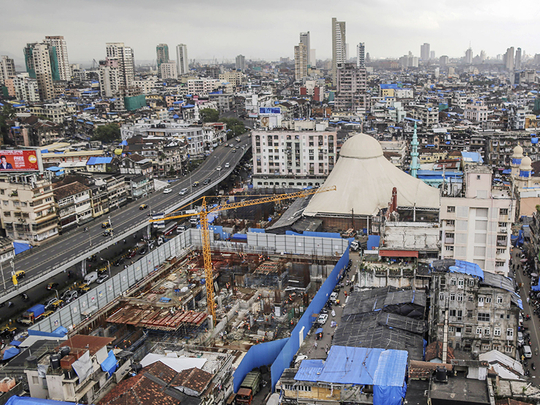
Mumbai: Shabbir Arsiwala’s family has lived for 100 years in a prime area of Mumbai in a noisy, two-room apartment he calls “foul-smelling and claustrophobic,” where a bucket placed along the peeling-paint-flecked walls collects dripping water and blue plastic sheeting keeps out rain. Soon, the 69-year-old former owner of a glass shop and his family will get a new, bigger home for free in one of 17 gleaming residential towers in India’s largest-ever urban redevelopment project.
“I am happy we will be getting new homes,” said Arsiwala, who with his wife, son, daughter-in-law and two grandchildren will move to nearby temporary housing while their building is demolished then reconstructed in four or five years. “I want to live the balance of my life in peace.”
The area, known as Bhendi Bazaar, will rehouse 20,000 people crammed into 250 crumbing buildings in an enclave in south central Mumbai, just north of the British-built train station formerly known as Victoria Terminus. Estimated to cost Rs40 billion (Dh2.2 billion or $600 million), the project is attracting bids from local and international companies with experience in urban redevelopment. And it’s being held up as an example for an India seeking to convert its centuries-old decaying housing into modern living.
The redevelopment is forecast to generate economic activity of as much as $4.8 billion and employment for tens of thousands of people over the next decade, according to Anand Laxmeshwar, a director at tax, merger and risk consultancy BMR Advisers Pvt.
Indian ‘trendsetter’
“It is a trendsetter for all the cities in India,” said Sambhaji Zende, chief executive officer of the state government’s Maharashtra Housing and Area Development Authority. “As for Mumbai, we will see other private developers also doing this, though the scale may not be as large as Bhendi Bazaar.”
The transformation of a neighbourhood of mostly Muslims” — in an India ruled by Prime Minister Narendra Modi and a state controlled by his Bharatiya Janata Party” — is also being lauded as an example of communal cooperation in city where tensions between Muslims and Hindu nationalists has flared. The BJP-led state government has set up a so-called war room to clear hurdles in the way of critical infrastructure projects, including Bhendi Bazaar.
Construction has already begun with the almost unanimous cooperation of residents”-with about 70 buildings demolished so far and more than 1,700 families, or about half of the total, already moved to free, fully furnished temporary housing and awaiting the completion of the first towers by 2018.
A key reason for the acquiescence is that the redevelopment project is being carried out as a philanthropic and religious endeavour: by the Saifee Burhani Upliftment Trust, a charity set up in 2009 by the late spiritual leader of the area’s Muslim Dawoodi Bohra community. The trust, while still in the process of choosing a developer to complete the complex, started on the construction in January.
The Trust contracted local developer Capacit’e Infraprojects Ltd. to develop the first of the towers and New Jersey-based Tricone consortium for another under its supervision until it finishes the process of choosing a final developer.
Bhendi Bazaar got its name from the shortened form of the area “behind the bazaar” of Crawford Market during the British colonial period, and it offered dormitory-style homes to male migrant workers on the docks of the nearby port of old Bombay. As the city’s flourishing trade and textile mills grew, labourers started bringing their families to live in these single-room units. Gangs operated in the area in the 1970s and ‘80s, and one of the country’s most-infamous gangsters, Dawood Ibrahim, linked to the Mumbai bomb blasts of 1993 and currently on India’s most-wanted list, resided in Bhendi Bazaar.
Today, more than 80 per cent of its buildings have been declared unsafe and unfit for habitation. The sprawling residences made of wood and brick are “affected by structural weakness,” the “size and state of the roads makes it almost impossible for vehicular traffic to move, lack of footpaths and congestion makes it a challenging prospect to even walk,” and “outdated sanitation and inadequate fire and safety measures leave the population very vulnerable,” according to the Saifee Burhani Upliftment Trust’s website. “Visitors are met with heaps of rubbish and rodents scurrying around. A once resplendent neighbourhood is slowing being gripped in the throes of decay.”
The Trust has gotten residents to sign over 220 of the 250 buildings. The developer ultimately chosen to complete the project will be granted 20 per cent of the land to sell privately in exchange for building the towers with new homes and shops for all the current residents, according to the trust’s CEO Abbas Master.
“Wherever there is change there is reluctance,” said Master, an engineer who has worked in construction in the US and around the world and returned to India a few years ago. “Generally people don’t have faith in developers. Here they had full faith and it helped.”
Bigger homes
It also helped that the Trust is providing a minimum of 32 square metres to residents for free, as well as free housing in the interim, as it wants to improve their living conditions, he said. The minimum required by the government for this type of development in Mumbai is 28 square metres.
“Nothing was thought or tried on this scale before,” said Master. “It will set a model for others.”
About 5 to 10 per cent of tenants are still holding out, Master said, and the state government will help acquire the remaining if they can’t be convinced, he said. Some residents protested the temporary relocation of certain shrines and planned a march that was later called off after meeting with Trust officials who assured them the shrines would be functional during the redevelopment.












